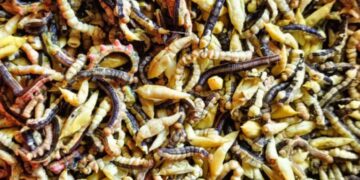Você já ouviu falar de uma goma de mascar antiviral ? Se a ideia parece absurda, prepare-se para mudar de opinião. Cientistas da Finlândia e dos Estados Unidos estão desenvolvendo uma invenção que promete revolucionar a forma como combatemos certos vírus: uma bala de chiclete feita com farinha de feijão lablab (Lablab purpureus ) que pode neutralizar vírus como os da gripe e do herpes. Sim, você leu certo — uma simples mastigação pode ajudar a reduzir a transmissão dessas doenças.
Como Funciona Essa Goma Milagrosa?
A chave do segredo está em uma proteína especial chamada FRIL , encontrada naturalmente nas sementes do feijão lablab. Essa proteína age como um “faz-tudo” no combate a vírus: ela literalmente “prende” partículas virais na boca, impedindo que elas se espalhem pelo corpo ou infectem outras pessoas.
Os pesquisadores descobriram que, ao mascar essa goma por apenas 15 minutos, mais de 50% da proteína FRIL é liberada e começa a agir. Em testes de laboratório, bastaram 40 miligramas de FRIL em uma pastilha de 2 gramas para reduzir a carga viral de gripe em mais de 95% . Para o herpes simples tipos 1 e 2 (HSV-1 e HSV-2), as doses necessárias foram ligeiramente maiores, mas os resultados foram igualmente impressionantes.
Além disso, a goma foi formulada seguindo padrões rigorosos de segurança alimentar e medicamentos, garantindo que seja segura para consumo humano. E tem mais: ela pode ser armazenada à temperatura ambiente por quase 800 dias sem perder sua eficácia. Ou seja, é prática, durável e acessível.
Por Que Atacar os Vírus na Boca?
O motivo dessa estratégia é simples: a boca é uma das principais portas de entrada e saída de vírus. Quando falamos, tossimos ou espirramos, partículas virais podem se espalhar rapidamente pelo ar ou por contato direto. Por isso, neutralizar esses vírus logo na fonte pode ser uma maneira eficiente de prevenir surtos.
“Reduzir a carga viral onde a transmissão ocorre com maior eficiência, como na cavidade oral, pode preencher uma lacuna importante na saúde pública”, explicou Henry Daniell , professor da Universidade da Pensilvânia e líder do estudo. Ele também destacou que estratégias como vacinas, embora cruciais, não são suficientes sozinhas, especialmente quando taxas de vacinação contra gripe e herpes são baixas.
Do Laboratório para o Mundo Real
Embora ainda esteja em fase experimental, a goma já mostrou resultados promissores em testes de laboratório. Os cientistas agora esperam avançar para ensaios clínicos em humanos, enquanto também exploram outras aplicações. Por exemplo, eles estão estudando o uso da farinha de feijão lablab em rações para aves, visando combater a gripe aviária, que já afetou milhões de animais na América do Norte nos últimos meses.
Essa abordagem é especialmente relevante porque cepas de gripe aviária, como H5N1 e H7N9, representam uma ameaça crescente tanto para animais quanto para humanos. Como a proteína FRIL já demonstrou capacidade de neutralizar esses vírus, a ideia é expandir seu uso para prevenir futuras pandemias.
Por Que Isso É Tão Empolgante?
Imagine poder prevenir a gripe ou o herpes mascando uma goma de mascar. Parece algo saído de um filme de ficção científica, mas está se tornando realidade. Além disso, essa solução é barata e fácil de usar, o que a torna ideal para ser distribuída em larga escala, especialmente em países com recursos limitados.
Outro ponto interessante é que a goma não depende de vacinas ou tratamentos médicos complexos. Ela age diretamente no local onde os vírus se multiplicam e se espalham, oferecendo uma alternativa simples e eficaz para reduzir infecções.
Conclusão: O Futuro Está na Boca
Embora ainda precise passar por testes clínicos, essa goma de mascar antiviral tem tudo para se tornar uma ferramenta poderosa no combate a doenças virais. Se os resultados forem confirmados em humanos, podemos estar prestes a testemunhar uma nova era na prevenção de gripes, herpes e até mesmo pandemias globais.
Então, da próxima vez que você pegar uma goma de mascar, quem sabe? Pode ser que esteja segurando uma arma secreta contra vírus perigosos.
Antiviral Chewing Gum: The New Weapon Against the Flu and Herpes
Scientists have created chewing gum capable of “trapping” viruses like the flu and herpes. It sounds weird, but it works!
Have you ever heard of antiviral chewing gum ? If the idea seems absurd, get ready to change your mind. Scientists from Finland and the United States are developing an invention that promises to revolutionize how we combat certain viruses: a simple piece of gum made from lablab bean powder (Lablab purpureus ) that can neutralize viruses like the flu and herpes. Yes, you read that right — a quick chew might help reduce the transmission of these diseases.
How Does This Miracle Gum Work?
The secret lies in a special protein called FRIL , which is naturally found in the seeds of the lablab bean. This protein acts as a “jack-of-all-trades” in fighting viruses: it literally “traps” viral particles in the mouth, preventing them from spreading through the body or infecting others.
Researchers discovered that after just 15 minutes of chewing, more than 50% of the FRIL protein is released and begins to work. In laboratory tests, just 40 milligrams of FRIL in a 2-gram gum tablet was enough to reduce flu viral loads by over 95% . For herpes simplex viruses (HSV-1 and HSV-2), slightly higher doses were required, but the results were equally impressive.
Additionally, the gum was formulated according to strict food safety and pharmaceutical standards, ensuring it’s safe for human consumption. And there’s more: it can be stored at room temperature for nearly 800 days without losing its effectiveness. So, it’s practical, durable, and accessible.
Why Target Viruses in the Mouth?
The reason behind this strategy is simple: the mouth is one of the main entry and exit points for viruses. When we talk, cough, or sneeze, viral particles can spread quickly through the air or direct contact. Neutralizing these viruses at the source can be an efficient way to prevent outbreaks.
“Reducing viral loads where transmission occurs most efficiently, such as in the oral cavity, could fill a major gap in public health,” explained Henry Daniell , a professor at the University of Pennsylvania and leader of the study. He also highlighted that strategies like vaccines, while crucial, aren’t sufficient alone, especially when vaccination rates for the flu and herpes are low.
From the Lab to the Real World
Although still in the experimental phase, the gum has already shown promising results in lab tests. Scientists now hope to move on to clinical trials in humans while exploring other applications. For example, they’re studying the use of lablab bean powder in poultry feed to combat avian flu, which has affected millions of birds in North America in recent months.
This approach is particularly relevant because strains of avian flu, like H5N1 and H7N9, pose a growing threat to both animals and humans. Since the FRIL protein has already demonstrated the ability to neutralize these viruses, the idea is to expand its use to prevent future pandemics.
Why Is This So Exciting?
Imagine being able to prevent the flu or herpes just by chewing gum. It sounds like something out of a sci-fi movie, but it’s becoming a reality. Plus, this solution is cheap and easy to use, making it ideal for large-scale distribution, especially in countries with limited resources.
Another interesting point is that the gum doesn’t rely on vaccines or complex medical treatments. It acts directly where viruses multiply and spread, offering a simple and effective alternative to reducing infections.
Conclusion: The Future Is in Your Mouth
Although it still needs to undergo clinical trials, this antiviral chewing gum has all the makings of a powerful tool in the fight against viral diseases. If the results are confirmed in humans, we may be on the verge of witnessing a new era in preventing the flu, herpes, and even global pandemics.
So, the next time you grab a piece of gum, who knows? You might be holding a secret weapon against dangerous viruses.

































